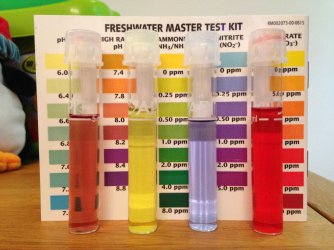Well, the most likely scenario then is the TapSafe being continually added to the tank is dealing with the ammonia, but I still wouldn't call it 'cycled' until you test for a solid week with zero ammonia or nitrite without any water changes.
You are using an out of date browser. It may not display this or other websites correctly.
You should upgrade or use an alternative browser.
You should upgrade or use an alternative browser.
Stable readings in cycle but it can't be complete? Can it!
- Thread starter djohnson1974
- Start date
djohnson1974
New Member
- Joined
- Dec 26, 2016
- Messages
- 25
- Reaction score
- 1
djohnson1974
New Member
- Joined
- Dec 26, 2016
- Messages
- 25
- Reaction score
- 1
djohnson1974
New Member
- Joined
- Dec 26, 2016
- Messages
- 25
- Reaction score
- 1
Yup. Definitely NOT a completed cycle.
Time to help with the nitrite. You will need to add SALT to combat the nitrite.
Time to help with the nitrite. You will need to add SALT to combat the nitrite.
http://www.fishforums.net/threads/rescuing-a-fish-in-cycle-gone-wild-part-il.433778/
CALCULATING HOW MUCH SALT TO ADD
PPM is a measure of concentration in water. You cannot weigh ppms. However, 1 mg/l is almost the exact equivalent in water to 1 ppm. So one can use ppm and mg/l interchangeably in this case. You can weigh milligrams.
To add 10 mg/l of chloride for every ppm of nitrite in the water, use the following steps:
1. Multiply your nitrite test reading by 10. This will give you the needed mg/l of chloride you need to add.
2. Calculate the actual volume in litres of the water in your tank. If your volume is in gallons you must convert this into liters. (As a rule, using the advertised volume of the tank at about 85% will put you in the right ballpark.) 1 gallon = 3.875 litres
3. Multiply the number in #1 above by the number of liters of water in #2 above to get the total number of mg of chloride you will need to add.
4. Because salt is roughly 2/3 chloride, you must multiply the number calculated in #3 by 1.5. You now know how many mg of salt you should add to the water. Dividing this number by 1,000 will convert this amount to grams which are easier to weigh for most people.
5. Do not add the dry salt directly to the tank. Remove some tank water to a container and mix the salt in that, then add the salt water to the tank spreading it around the surface.
Hint: We have calculated a handy conversion from grams to volume so one can measure in tea or table spoons which most folks are likely to have while a gram scale is not. The following calculations were made using an Ohaus triple beam scale: ¼ teaspoon of salt shaker sized table salt weighs 2 grams.
The readings used in this article are for API and similar type test kits which measure in total ions. Some kits will measure using a different scale, they are only measuring the nitrogen ions. You can tell when a kit reads just the nitrogen ions by the way they state things. The typical kits will say they measure Total Ammonia (NH3 + NH4), Nitrite (NO2) or Nitrate (N03). Kits that measure only the nitrogen ions will usually say they measure Total Ammonia-Nitrogen (NH3-N + NH4-N), Nitrite-Nitrogen (NO2-N) or Nitrate-Nitrogen (NO3-N).
djohnson1974
New Member
- Joined
- Dec 26, 2016
- Messages
- 25
- Reaction score
- 1
Great, thanks for the advice. I assume the salt will no affect the development of the good bacteria in the filer?
Nope. More importantly, it will protect the fish while leaving the nitrite in the tank to allow the bacterial colony to grow... whereas as water changes removes the nitrite which would slow the colony's growth.
djohnson1974
New Member
- Joined
- Dec 26, 2016
- Messages
- 25
- Reaction score
- 1
Salt appears to be working. Nitrite levels remain at 0.25 and fish still look perfectly healthy.
I appreciate your advice, I'd be a bit lost without it as there's so much info out there on the inter web!
I appreciate your advice, I'd be a bit lost without it as there's so much info out there on the inter web!
Glad to be able to help. Keep us posted! 

djohnson1974
New Member
- Joined
- Dec 26, 2016
- Messages
- 25
- Reaction score
- 1
Weekly, and replace the salt you remove, but don't replace all the salt unless you are doing a full water change.
Having the nitrite in the tank will speed the process of the colony growing. The salt will protect the fish in the meantime.
Having the nitrite in the tank will speed the process of the colony growing. The salt will protect the fish in the meantime.
djohnson1974
New Member
- Joined
- Dec 26, 2016
- Messages
- 25
- Reaction score
- 1
So cycle finally complete, had 2 readings with zero ammonia and zero nitrites. Next question is fish stocking but I guess that's for another thread. Thanks for the help guys
Great to hear it!
Similar threads
- Replies
- 21
- Views
- 911
- Replies
- 5
- Views
- 337
- Replies
- 13
- Views
- 466
- Replies
- 26
- Views
- 2K




